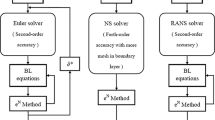Abstract
There are currently three different game strategies originated in economics: (1) Cooperative games (Pareto front), (2) Competitive games (Nash game) and (3) Hierarchical games (Stackelberg game). Each game achieves different equilibria with different performance, and their players play different roles in the games. Here, we introduced game concept into aerodynamic design, and combined it with adjoint method to solve multi-criteria aerodynamic optimization problems. The performance distinction of the equilibria of these three game strategies was investigated by numerical experiments. We computed Pareto front, Nash and Stackelberg equilibria of the same optimization problem with two conflicting and hierarchical targets under different parameterizations by using the deterministic optimization method. The numerical results show clearly that all the equilibria solutions are inferior to the Pareto front. Non-dominated Pareto front solutions are obtained, however the CPU cost to capture a set of solutions makes the Pareto front an expensive tool to the designer.
Similar content being viewed by others
References
Cohon J.L. (1978) Multiobjective programming and planning. Academic, New York
Deb K. (2001) Multi Objective Optimization Using Evolutionary Algorithms. Wiley, New York
Nash J.F. (1951) Non-coorperative games. Ann. Math. 54(2): 286–295
Basar T., Olsder G.J. (1995) Dynamic noncooperative game theory. Academic, Bodmin
Ehtanzo H. (1989) Incentive strategies and equilibria for dynamic games with delayed information. J. Opt. Theory Appl. 63(3): 355–370
Ehtanzo H. (1993) A cooperative incentive equilibrium for a resource management problem. J. Eco. Dynam. Control 17(4): 659–678
Marco N.M., Désidéri J.A., Lanteri S. Multi-objective optimization in CFD by genetic algorithms, INRIA Report RR-3686, INRIA Sophia Antipolis (1999)
Lions J.L.(1969) Contrôle optimal des systèmes fouvernés par des equations aux dérivées partielles. Gauthier-Villars, Paris
Jameson A. (1988) Aerodynamic design via control theory. J. Sci. Comput. 3(3): 233–260
Tang Z.L.: The research on optimum aerodynamic design using CFD and control theory. (Ph.D. Thesis), NUAA, Nanjing (2000)
Leoviriyakit, K., Kim, S., Jameson, A.: Viscous aerodynamic shape optimization of wings including planform variables. In: 21st applied aerodynamics conference, Orlando, AIAA paper 2003–3498 (2003)
Osborne M.J., Rubinstein A. (1997) A course in game theory. Massachusetts Institute of Technology, Cambridge
Tang Z.L., Désidéri JA., Périaux J. Multi-objective design strategies using deterministic optimization with different parameterization in aerodynamics. In: Neittaanmäki P., Rossi T., Korotov S., Oñate E., Périaux J., Knörzer D. (eds) Proceedings of European congress on computational methods in applied sciences and engineering, Jyväskylä (2004)
Whitney E.J., Gonzalez L.F., Srinivas K., Periaux J. (2003) Adaptive evolution design without specific knowledge: UAV application. In: Bugeda G., Désidéri J.A., Periaux J., Schoenauer M., Winter G. (eds) Proceedings of international congress on evolutionary methods for design optimization and control with application to industrial problems. CIMNE, Barcelona
Padovan L., Pediroda V., Poloni C. (2003) Multi objective robust design optimization of airfoils in transonic Field (M.O.R.D.O). In: Bugeda G., Désidéri J.A., Periaux J., Schoenauer M., Winter G. (eds) Proceedings of international congress on evolutionary methods for design optimization and control with application to industrial problems. CIMNE, Barcelona
Tang, Z.L., Désidéri, J.A., Périaux, J.: Virtual and real game strategies for multi-objective optimization in aerodynamics, INRIA Report RR-4543, INRIA Sophia Antipolis (2002)
Author information
Authors and Affiliations
Corresponding author
Additional information
The project supported by the National Natural Science Foundation of China (10372040) and Scientific Research Foundation (SRF) for Returned Oversea’s Chinese Scholars (ROCS) (2003-091). The English text was polished by Yunming Chen.
Rights and permissions
About this article
Cite this article
Tang, Z. Multi-objective Optimization Strategies Using Adjoint Method and Game Theory in Aerodynamics. Acta Mech Mech Sinica 22, 307–314 (2006). https://doi.org/10.1007/s10409-006-0014-9
Received:
Revised:
Accepted:
Published:
Issue Date:
DOI: https://doi.org/10.1007/s10409-006-0014-9




